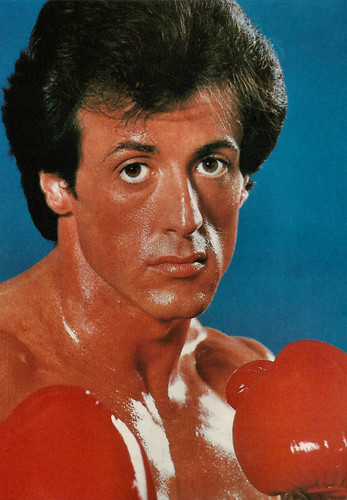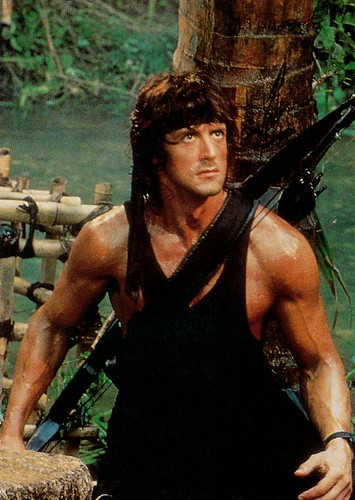
English postcard by Star-Graphics, no. S 140. Photo: Sylvester Stallone as Rocky.

English postcard by Superior, no. PC 92. Photo: Illuminations 3 + Ltd. Sylvester Stallone in Rambo - First Blood Part II (George P. Cosmatos, 1985).
The stuff of cinematic legends
Sylvester Gardenzio Stallone was born in 1946, in New York's gritty Hell's Kitchen. His parents were Jackie Stallone (née Labofish), an astrologer, and Frank Stallone, an Italian immigrant who worked as a beautician, and hairdresser.
After his parents divorced, he moved with his mother and her new husband, a pizza manufacturer, Anthony 'Tony' Filiti, to Philadelphia. His siblings are actor Frank Stallone, half-sister Toni D'Alto, and Dante Stallone. The young Stallone attended the American College of Switzerland and the University of Miami, eventually obtaining a B.A. degree.
He was 23 years old when he got his first starring role in the softcore sex film The Party at Kitty and Stud's (Morton M. Lewis, 1970) in which he played the role of Stud 'The Italian Stallion'. He was paid $200 to play the sex-craved gigolo and appeared nude. In 1976, the film was re-released as The Italian Stallion after Sly's success with Rocky (John G. Avildsen, 1976).
In between, he first struggled in small parts in films such as the thriller Klute (Alan J. Pakula, 1971) starring Jane Fonda, and the comedy Bananas (Woody Allen, 1971). He got a crucial career break alongside fellow young actors Henry Winkler and Perry King, sharing lead billing in the effectively written teen gang film The Lords of Flatbush (Martin Davidson, Stephen Verona, 1974). He also wrote the screenplay for the modestly successful film.
Further film and television roles followed, most of them in uninspiring productions except for the opportunity to play a megalomaniac, bloodthirsty race driver named "Machine Gun Joe Viterbo" opposite David Carradine in the Roger Corman-produced Death Race 2000 (Paul Bartel, 1975).
However, Stallone was also keen to be recognised as a screenwriter, not just an actor, and, inspired by the 1975 Muhammad Ali-Chuck Wepner fight in Cleveland, Stallone wrote a film script about a nobody fighter given the "million to one opportunity" to challenge for the heavyweight title. Rocky (John G. Avildsen, 1976) became the stuff of cinematic legends, scoring ten Academy Award nominations, winning the Best Picture Award of 1976, and triggering one of the most financially successful film series in history.
Whilst full credit is wholly deserved by Stallone, he was duly supported by tremendous acting from fellow cast members Talia Shire, Burgess Meredith, and Burt Young, and director John G. Avildsen gave the film an emotive, earthy appeal from start to finish. Stallone had truly arrived on his terms and offers poured in from various studios eager to secure Hollywood's hottest new star.

British postcard by Santoro Graphics, London, no. C201. Photo: Twentieth Century Fox. Sylvester Stallone in Rhinestone (Bob Clark, 1984).

French postcard by Editions F. Nugeron, no. Star 105. Photo: Carolco / Anabasis Investments BV. Sylvester Stallone in Rambo - First Blood Part II (George P. Cosmatos, 1985).
Green Beret John Rambo
Sylvester Stallone followed Rocky (John G. Avildsen, 1976) with F.I.S.T. (Norman Jewison, 1978), loosely based on the life of Teamsters boss Jimmy Hoffa, and Paradise Alley (Sylvester Stallone, 1978) before pulling on the boxing gloves again to resurrect Rocky Balboa in the sequel Rocky II (Sylvester Stallone, 1979). The second outing for the "Italian Stallion" wasn't as powerful or successful as the first Rocky, however, it still produced a strong box office.
Subsequent films Nighthawks (Bruce Malmuth, 1981) with Rutger Hauer, and Escape to Victory (John Huston, 1981) with Michael Caine and Pelé failed to ignite with audiences, so Stallone was once again lured back to familiar territory with Rocky III (Sylvester Stallone, 1982) and a fearsome opponent in "Clubber Lang" played by muscular ex-bodyguard, Mr. T. The third "Rocky" installment far outperformed the first sequel in box office takings, but Stallone retired his prizefighter for a couple of years as another series was about to commence for the busy actor.
The character of Green Beret "John Rambo" was the creation of Canadian-born writer David Morrell, and his novel was adapted to the screen with Stallone in the lead role in First Blood (Ted Kotcheff, 1982), also starring Richard Crenna and Brian Dennehy. The film was a surprise hit that polarised audiences because of its commentary about the Vietnam war, which was still relatively fresh in the American public's psyche.
Political viewpoints aside, the film was a worldwide smash, and a sequel soon followed with Rambo: First Blood Part II (George P. Cosmatos, 1985), which drew even stronger criticism from several quarters owing to the film's plotline about American MIAs allegedly being held in Vietnam. But they say there is no such thing as bad publicity, and "John Rambo's" second adventure was a major money-spinner for Stallone and cemented him as one of the top male stars of the 1980s.
In between, he did his own singing in Rhinestone (Bob Clark, 1984) with Dolly Parton. Riding a wave of amazing popularity, Stallone called on old sparring partner Rocky Balboa to climb back into the ring to defend American pride against a Soviet threat in the form of a towering Russian boxer named "Ivan Drago" played by curt Dolph Lundgren in Rocky IV (Sylvester Stallone, 1985). The fourth outing was somewhat controversial with "Rocky" fans, as violence levels seemed excessive compared to previous "Rocky" films, especially with the savage beating suffered by Apollo Creed, played by Carl Weathers, at the hands of the unstoppable "Siberian Express".

Italian postcard by Vittorius, Roma (Rome), no. VR 510. Sylvester Stallone and Dolph Lundgren in Rocky IV (Sylvester Stallone, 1985).

English postcard by Star-Graphics, London, no. S 133. Sylvester Stallone and Dolph Lundgren in Rocky IV (Sylvester Stallone, 1985).
Worst Actor of the Century award
Sylvester Stallone continued forward with a slew of macho character-themed films that met with a mixed reception from his fans. Cobra (George P. Cosmatos, 1986) with his wife Brigitte Nielsen was a clumsy mess, Over the Top (Menahem Golan, 1987) was equally mediocre, Rambo III (Peter MacDonald, 1988) saw Rambo take on the Russians in Afghanistan, and cop buddy film Tango & Cash (Andrey Konchalovskiy, 1989) just did not quite hit the mark, although it did feature a top-notch cast and there was chemistry between Stallone and co-star Kurt Russell.
Philadelphia's favourite mythical boxer moved out of the shadows for his fifth screen outing in Rocky V (John G. Avildsen, 1990) tackling Tommy "Machine" Gunn played by real-life heavyweight fighter Tommy Morrison, the great-nephew of screen legend John Wayne.
Sly quickly followed with the lukewarm comedy Oscar (John Landis, 1991) with Ornella Muti, the painfully unfunny Stop! Or My Mom Will Shoot (Roger Spottiswoode, 1992) with "Golden Girl" Estelle Getty, the futuristic action film Demolition Man (Marco Brambilla, 1993) with Wesley Snipes and Sandra Bullock, and the comic book-inspired Judge Dredd (Danny Cannon, 1995).
Interestingly, Stallone then took a departure from the gung-ho steely characters he had been portraying to stack on a few extra pounds and tackle a more dramatically challenging role in the intriguing Cop Land (James Mangold, 1997), also starring Harvey Keitel, Robert De Niro, and Ray Liotta. It isn't a classic of the genre, but Cop Land (1997) certainly surprised many critics with Stallone's understated performance.
He has been nominated a record 30 times for the Golden Raspberry Awards, usually in the "Worst Actor" category, and has won 10 times. The Golden Raspberry Award Foundation awarded him a special "Worst Actor of the Century" award in 2000.

English postcard, no. FA 220. Sent by mail in 1991. Sylvester Stallone in Cobra (George P. Cosmatos, 1986).

French postcard, no. C 451. Sylvester Stallone in Cliffhanger (Renny Harlin, 1993).
An enviable and highly respected career in Hollywood
Sylvester Stallone lent his voice to the animated adventure story Antz (Eric Darnell, Tim Johnson, 1998), reprised the role made famous by Michael Caine in a terrible remake of Get Carter (Stephen Kay, 2000), climbed back into a race car for Driven (Renny Harlin, 2001), and guest-starred as the 'Toymaker' in the third chapter of the popular 'Spy Kids' film series, Spy Kids 3: Game Over (Robert Rodriguez, 2003).
In 2005 he published his book 'Sly Moves: My Proven Program to Lose Weight, Build Strength, Gain Will Power, and Live Your Dream'. Showing that age had not wearied his two most popular series, Sylvester Stallone brought back never-say-die boxer Rocky Balboa to star in Rocky Balboa (Sylvester Stallone, 2006), and Vietnam veteran Rambo reappeared after a 20-year hiatus to once again right wrongs in the jungles of Thailand in Rambo (Sylvester Stallone, 2008).
Another success was The Expendables (Sylvester Stallone, 2010), abound a band of highly skilled mercenaries played by Bruce Willis, Arnold Schwarzenegger, and other 'dinosaurs' from the 1980s action film teamed up with each other. The action film opened at number one at the U.S. box office with a first weekend gross of $35 million.
This makes Sylvester Stallone the only person in Hollywood history to have starred in films that have opened atop the box office charts over five consecutive decades. Soon followed the less successful sequels The Expendables 2 (Simon West, 2012) and The Expendables 3 (Patrick Hughes, 2014).
In between, he also appeared with Schwarzenegger in Escape Plan (Mikael Håfström, 2013). Stallone got rave reviews, his first Golden Globe, and an Oscar nomination for his role in the sports film Creed (Ryan Coogler, 2015) opposite Michael B. Jordan. Once again he played Rocky Balboa who serves as a trainer and mentor to Adonis Johnson, the son of his late friend and former rival Apollo Creed.
In 2017, Stallone appeared in Guardians of the Galaxy Vol. 2 (James Gunn, 2017) as Stakar Ogord / Starhawk, the leader of a Ravagers faction. Then followed Creed II (Steven Caple Jr., 2018) and Rambo: Last Blood (Adrian Grunberg, 2019). The latter film grossed $91 million worldwide against a production budget of $50 million.
Sylvester Stallone married three times. His first wife was Sasha Czack (1974-1985) with whom he has two children: Sage and Seargeoh Stallone. Sage acted with Sylvester in Rocky V (1990) and Daylight (1996) and was found dead in 2012 in Los Angeles. From 1985 till 1987, Sly was married to Danish actress Brigitte Nielsen. Since 1997, he is married to Jennifer Flavin, with whom he has three children: Sophia Rose, Sistine Rose, and Scarlet Rose Stallone.
Firehouse at IMDb: "Love him or loathe him, Sylvester Stallone has built an enviable and highly respected career in Hollywood, plus, he has considerably influenced modern popular culture through several of his iconic film characters."

English postcard.
Sources: Wikipedia and IMDb.
No comments:
Post a Comment